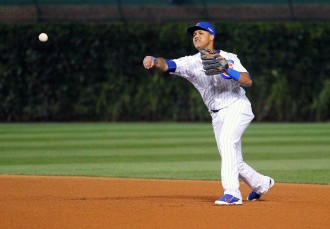The MLB offseason has yet to kick into full gear, but you wouldn’t know it from the way rumors are swirling around the New York Yankees.
Most recently the Bronx Bombers have been linked to Starlin Castro in a trade that could involve Brett Gardner according to Mark Feinsand of the New York Daily News. While it’s hard to know how much fire is burning beneath this smoke, it’s the sort of framework that makes some sense with two well-compensated potentially-redundant veterans switching teams.
There would have to be other players involved to make it work, but if you squint you can see it. However, one aspect of the story is both obvious and illogical, the idea of Castro as a second baseman.
As Feinsand explains, “[Starlin] Castro would fill a need for the Yankees at second base, where they currently have a platoon of Dustin Ackley and Rob Refsnyder.”
It is true that the Yankees have an uncertain situation at second base and a shortstop in Didi Gregorius who led the team in WAR in 2015. So it’s clear where the hole is. That doesn’t mean shoving Castro into it is justified.
Over the course of his career Castro has accumulated 106.6 Runs Above Replacement. For a 25-year-old it’s hard to complain about a number like that. However, 38.6 of those runs have been a function of his positional adjustment for being a shortstop. He has racked up 36.2 percent of his value just for standing between third base and second base a bunch of times.
That characterization undoubtedly undersells the difficulty of being a major league shortstop, but if the Yankees pick him up and play him at second they are cutting into his value significantly. For a frame of reference, Robinson Cano has put up only 20.1 runs of positional value in his career, and a durable second baseman is worth only 1.5-2.5 extra runs a year compared to 5.5-7.5 for a shortstop.
A move to second doesn’t change Castro as a ballplayer in a meaningful way, but it would change the lens through which we have to evaluate his value. He has been useful to the Cubs by being approximately a league-average hitter and a competent shortstop. That combination makes you an asset. Being a league-average hitter and a competent second baseman isn’t nearly as impressive.
In theory, the transition to the keystone could improve his ability to make a defensive impact. Converted shortstops like Ryan Goins have become defensive aces at second in the past. That being said, historically Castro’s biggest problem has been sloppiness and lapses in judgement which seem unlikely to change just from lining up at a different spot.
It’s possible to consider Castro something of an upside play offensively, especially considering his age and how strong he was in 2014, but unless he develops significantly more power, he’s going to be fairly BABIP reliant year-to-year. His talent has often been considered to surpass his production, but it’s naive to assume he’d break from his well-established patterns at the plate simply by donning the pinstripes.
In fact, he projects to be a worse hitter than both Refsnyder and Ackley in 2016 according to Steamer.
| Player | AVG | OBP | SLG | wRC+ |
|---|---|---|---|---|
| Starlin Castro | .272 | .313 | .404 | 94 |
| Rob Refsnyder | .269 | .335 | .409 | 104 |
| Dustin Ackley | .261 | .318 | .419 | 100 |
Castro has tantalizing gifts and a not-unreasonable contract so it’s easy to see why his name is going to be mentioned a great deal this off-season. He’s likely to have a new home soon, but it’s shouldn’t be with the Yankees and it definitely shouldn’t be at second base.
(Photo: Dennis Wierzbecki-USA Today Sports)

He already wears pinstripes.